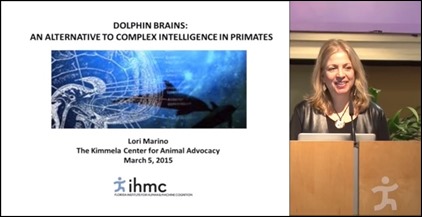Brainiacs of the Sea
March 5, 2015: Kimmela Center Executive Director Lori Marino gave a talk entitled “Dolphin Brains: An Alternative to Complex Intelligence in Primates” at the Institute for Human and Machine Cognition (IHMC) in Ocala, Florida.
The award winning IHMC Evening Lecture Series provides a community forum where individuals gather to hear presentations in topics from science and technology to urban planning to aviation.
The talk explored dolphin and whale evolution, brain size and cognitive complexity with an audience of over 300. Earlier in the day, Dr. Marino met with engineers, scientists and high school interns at the Institute to talk about artificial and nonhuman intelligence and explore the many fascinating possibilities for understanding how intelligence and consciousness evolves.
Family, friends, and freedom are as important to dolphins as they are to us humans.After the talk the IHMC staff, board members and supporters held a dinner in her honor, after which the audience and dinner companions engaged in a round-robin game of “Ask the Scientist” where everyone got to ask a question they’ve always wanted answered about dolphins and whales.
Dr. Marino explained that family, friends, and freedom are as important to dolphins as they are to us humans. And people were surprised to learn, for example, that:
- The closest living relative to dolphins and whales is the hippopotamus. (One audience member guessed correctly!)
- Dolphins and whales have the second highest level of encephalization (a measure of relative brain size) next to modern humans and have had their big brains for 15 million years – demonstrating that our species is just an upstart when it comes to braininess.
- Dolphin and whale brains, on one hand, and primate brains, on the other, represent two very different ways large complex brains have evolved – “two different ways brains can produce complex intelligence and self-awareness.”
- In addition to being able to recognize themselves in mirrors, dolphins can also play a form of the game Jeopardy in which they report (by pressing paddles) how certain they are about the answer to questions on a continuum of easy to very difficult. This ability, and self-recognition, mean that dolphins are self-aware.
Although humans like to pride themselves on their cultural sophistication, dolphins and whales share a lot of these characteristics like culture, social clubs, cooperation, and even tool use.

